Uncategorized
How Trump Can Help Crypto on Day One
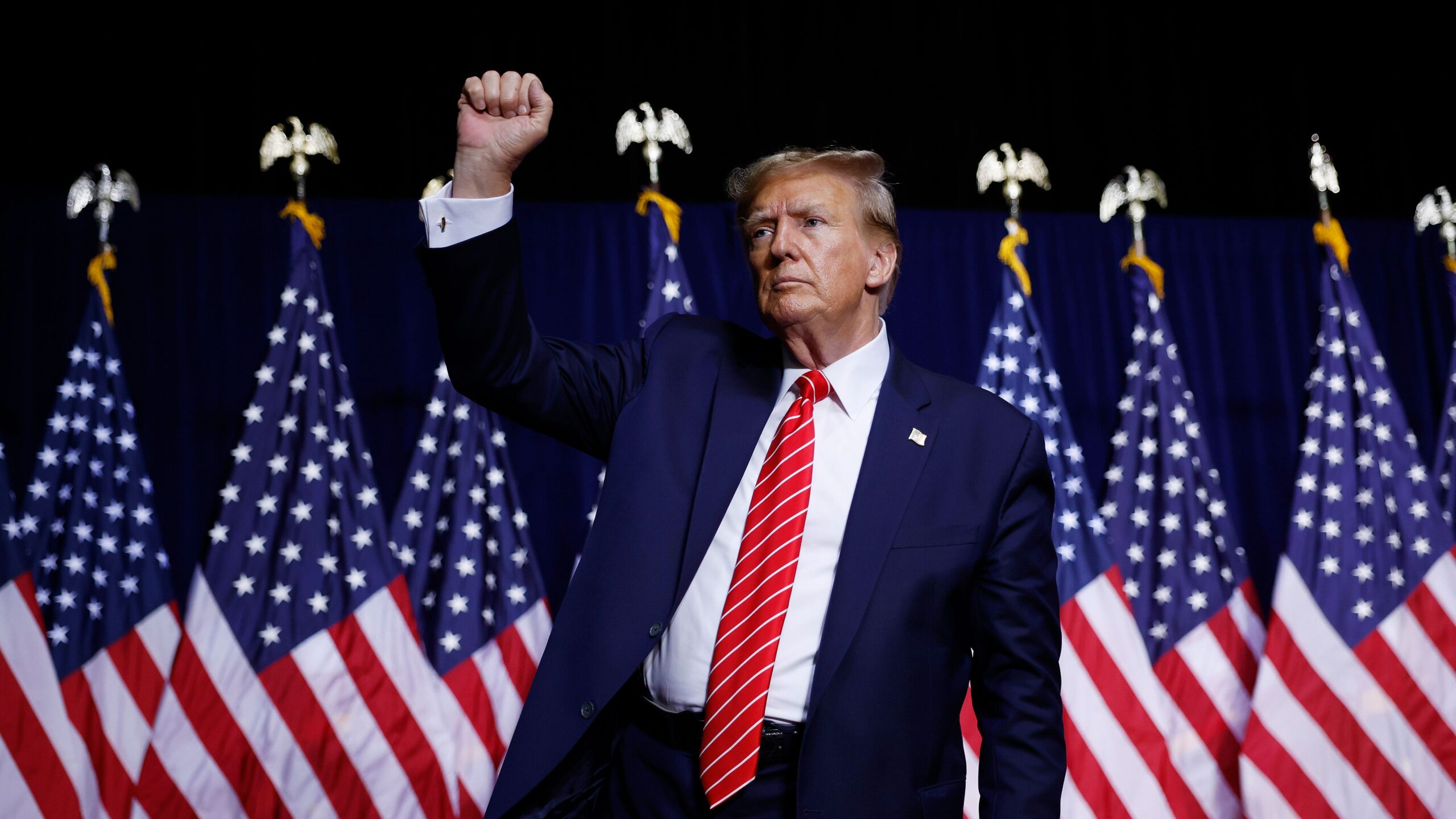
Dear President Elect Trump,
As the co-head of a major law firm’s digital assets practice, I am hopeful that your nominee to chair the Securities Exchange Commission (SEC) will make much-needed (and long-overdue) reforms to the way the SEC approaches crypto market regulation in the United States.
However, as you know, it will take some time for your nominee to be confirmed as SEC chair, and for him to formulate new SEC guidance and rules for the crypto industry. Bearing that in mind, I write respectfully to propose an Executive Order that you can issue—on Day One of your Presidency—to help restore American leadership in the burgeoning crypto financial system.
While other countries have raced to create regulatory clarity for crypto entrepreneurship to thrive, U.S. lawmakers and regulators have thus far refused to mold and modernize decades-old rules that were never meant to apply to this groundbreaking technology, leaving U.S. market participants adrift in a sea of regulatory ambiguity. All the while, the SEC under its current chair, Gary Gensler, has teed up case-after-case against crypto companies, projects and founders based on allegations that they violated these outmoded and anachronistic requirements, even where there are no allegations of fraud or actual harm to investors.
It should be no surprise that this regulation-by-enforcement approach has chased many of the leading innovators and businesses in the digital assets sector offshore, jeopardizing America’s leadership position in the global economy.
How to find our way again
The good news is that it’s not too late to turn things around. The current moment presents a once-in-a-generation opportunity to make America the crypto capital of the world, and harness the transformative promise that digital assets and blockchain technology hold for our country. While there are many legislative, regulatory and tax reforms that will be needed to seize this opportunity, there is one immediate action you can take—on Day One of your Presidency—to pave the way for the crypto sector’s resurgence in America.
You can issue an Executive Order on January 20 directing all federal agencies to:
1. Immediately stay all investigations, enforcement actions and prosecutions of crypto companies, projects and founders unless they involve credible allegations of (a) acts of fraud or other intentional misconduct that harms investors or other victims, or (b) conduct that threatens our national security.
2. Provide a written report to the Office of the President within 180 days detailing why the relevant agency should not immediately terminate such proceedings.
3. Promptly terminate all investigations, enforcement actions, or prosecutions of crypto companies, projects or founders that do not warrant continued prosecution.
What the proposed executive order would accomplish
This proposed Executive Order would be vitally important to undo the chilling effect on the digital assets industry that has been caused by the explosion in recent years of government enforcement litigation, including actions brought against good actors who at most did not follow outdated and inapplicable rules without causing harm to a single investor. The SEC, most notably, has extracted billions of dollars in disgorgement—a financial penalty which, several courts have held, should be used only in cases where an alleged violation of law caused pecuniary harm to victims—in victimless crypto enforcement lawsuits.
Many of these lawsuits have sought to impose draconian sanctions against legitimate crypto market participants that are providing the digital infrastructure needed for these markets to flourish in the United States. The time has come to rethink this blunderbuss approach to enforcement. The proposed Executive Order can achieve this on Day One of your Presidency.
To be clear, you have ample authority to do this. Article II of the Constitution gives the President the power to unilaterally issue such Executive Orders without legislation or regulatory rulemaking. The Justice Department’s own Office of Legal Counsel has opined that Article II empowers the President to compel all federal agencies—including independent regulatory agencies such as the SEC—to comply with executive orders, such as the one proposed here, that would apply generally to all Executive Branch agencies.
You can make America the center of the global crypto economy. The proposed Executive Order can be your first step, on Day One of your Presidency, towards achieving that goal.
Note: The views expressed in this column are those of the author and do not necessarily reflect those of CoinDesk, Inc. or its owners and affiliates.
Uncategorized
Bitcoin-Gold Price Ratio’s 10% Surge Greenlights Bullish Flag Pattern: Technical Analysis

This is a daily technical analysis by CoinDesk analyst and Chartered Market Technician Omkar Godbole.
The ratio between the per-piece dollar price of bitcoin (BTC) and gold’s (XAU) per-ounce dollar-denominated price rose over 10% to 33.33 last week, registering its best performance in two months, according to data source TradingView.
The double-digit gain, representing BTC’s outperformance relative to gold, marked a breakout from the bull flag pattern. The so-called flag breakout signals a continuation of the rally from lows near 24.85 reached on April 11.
A bull flag pattern is characterized by a sharp uptrend followed by a relatively brief counter-trend consolidation that usually refreshes higher, as is the case with the BTC-gold ratio.
The flag breakout is said to extend the upside by an amount equivalent to the magnitude of the initial rally. So, the ratio could rise to 42.00, topping the record high of 40.73 hit in December.
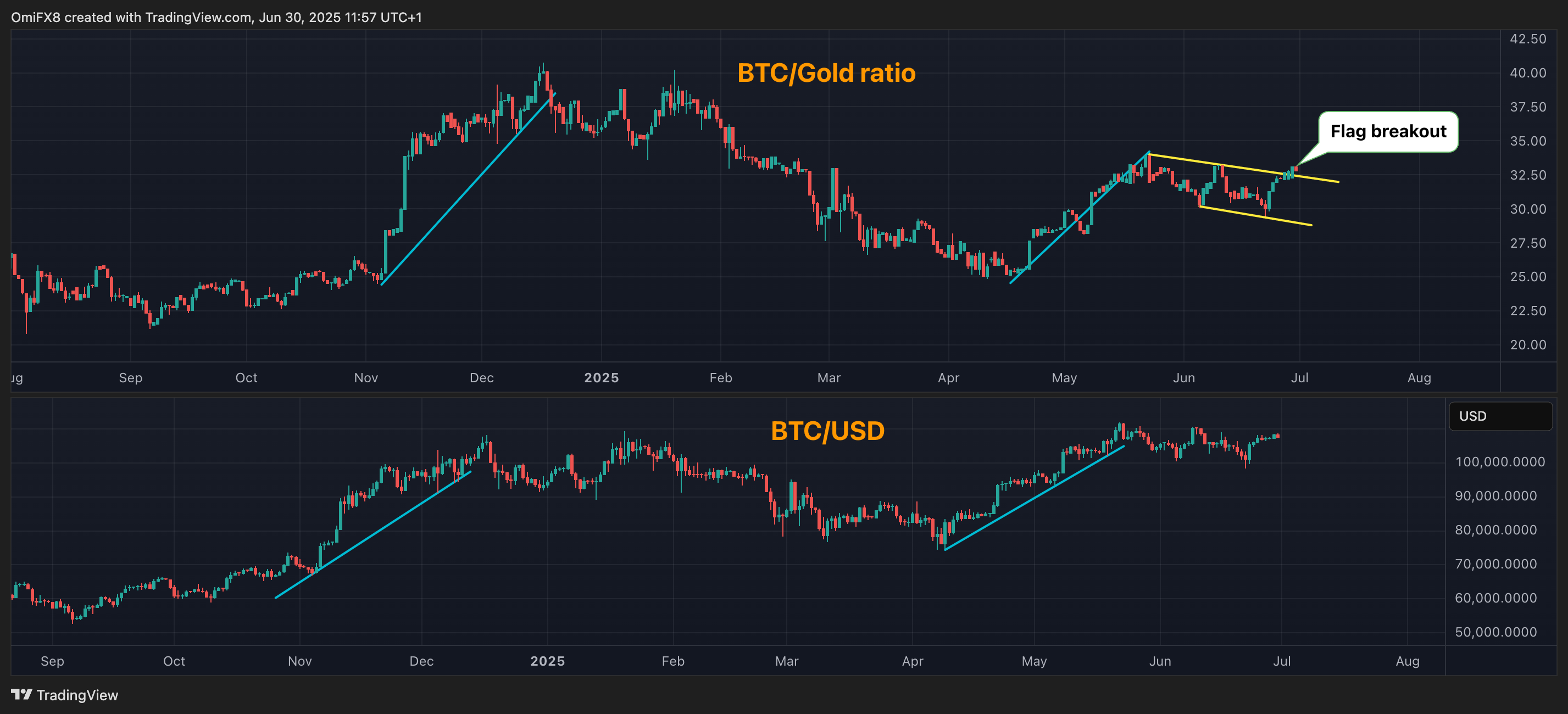
Previous uptrends in the ratio have been characterized by sharp upswings in BTC’s dollar-denominated price, as observed in late 2024 and in April and May, rather than gold dropping more than BTC.
Uncategorized
Crypto Daybook Americas: Bitcoin ‘Calm Rarely Lasts’

By Omkar Godbole (All times ET unless indicated otherwise)
Just bet on the price movement, not the direction.
That’s the message from a market maker as bitcoin (BTC) continues to bore traders with prices caught in crosswinds of continued ETF inflows and selling by long-term holders.
Its solidity above $100,000 has sparked a meltdown in volatility metrics, including Deribit’s DVOL, which measures the 30-day implied or expected BTC price turbulence. The index fell below an annualized 40%, the lowest in nearly two years.
«Compared to equities, Tesla and Coinbase vols are ~50% richer, highlighting just how quiet crypto has become,» Jimmy Yang, a co-founder of institutional liquidity provider Orbit Markets, told CoinDesk. «But calm rarely lasts. Historically, vol tends to bounce from here. With direction unclear — breakout or breakdown — going long volatility via vol swaps offers a clean way to position for a return of movement.»
A volatility swap is a forward contract that allows investors to trade the future realized volatility of an underlying asset. Another way to bet on price turbulence is through volatility futures, and some traders are already doing so.
Perpetuals linked to Volmex Finance’s bitcoin and ether (ETH) implied volatility indices (BVIV and EVIV, respectively) debuted on the decentralized leverage trading platform gTrader last week. The cumulative trading volume in these perpetuals is fast approaching the $1 million mark.
In other news, President Donald Trump said he wants interest rates cut to 1% from the current range of 4.25%-4.0% and would «love» it if Federal Reserve Chair Jerome Powell were to resign. The Fed, however, is unlikely to cut rates unless the labor market softens, according to Dario Perkins, managing director of global macro at TS Lombard. That data is due later this week.
National Bank of Kazakhstan Governor Timur Suleimenov reportedly said the country will establish a crypto reserve, which will be managed by a National Bank affiliate. Meanwhile, Bhutan detailed plans to develop crypto-backed tourism to attract high-value global travelers.
Leading Ethereum liquid staking platform, Lido, implemented a two-way governance structure, allowing holders of staked ether (stETH) to delay or block proposals made by holders of LDO, its native token. The stETH holders can do so by locking in their tokens in an escrow contract.
In traditional markets, Nasdaq E-mini futures rose 0.6% to new lifetime highs, suggesting a return of the «U.S. exceptionalism narrative.» The dollar index, however, showed little signs of life. Stay alert!
What to Watch
- Crypto
- June 30: BNB Chain (BNB) activates the Maxwell hard fork on BNB Smart Chain mainnet, halving block times 0.75 seconds to enhance transaction speed, validator coordination and network scalability.
- June 30: CME Group will launch spot-quoted futures, allowing trading in bitcoin, ether and major U.S. equity indices with contracts holdable for up to five years.
- June 30: Zilliqa (ZIL) launches a new staking platform at stake.zilliqa.com, enabling instant staking and unstaking with no waiting period, and offering a boosted APR starting at 55.85% for early users, following the Zilliqa 2.0 mainnet upgrade.
- June 30, 11 a.m.: Robinhood Markets is hosting «Robinhood Presents: To Catch a Token,» its first international crypto-focused keynote from the French Riviera. Livestream link.
- Macro
- Day 1 of 3: ECB Forum on Central Banking (Sintra, Portugal)
- July 1, 9 a.m.: S&P Global releases June Brazil data on manufacturing and services activity.
- Manufacturing PMI Prev. 49.4
- July 1, 9:30 a.m.: “High Level Policy Panel” discussion chaired by Fed Chair Jerome H. Powell at the ECB Forum on Central Banking in Sintra, Portugal. Livestream link.
- July 1, 9:45 a.m.: S&P Global releases (final) June U.S. data on manufacturing and services activity.
- Manufacturing PMI Est. 52 vs. Prev. 52
- July 1, 10 a.m.: The Institute for Supply Management (ISM) releases June U.S. services sector data.
- Manufacturing PMI Est. Est. 48.8 vs. Prev. 48.5
- July 1, 10 a.m.: The U.S. Bureau of Labor Statistics releases April U.S. labor market data (i.e. the JOLTS report).
- Job Openings Est. 7.45M vs. Prev. 7.391M
- Job Quits Prev. 3.194M
- July 2, 9:30 a.m.: S&P Global releases June Canada data on manufacturing and services activity.
- Manufacturing PMI Prev. 46.1
- July 3, 8:30 a.m.: The U.S. Bureau of Labor Statistics releases June employment data.
- Non Farm Payrolls Est. 129K vs. Prev. 139K
- Unemployment Rate Est. 4.2% vs. Prev. 4.2%
- Government Payrolls Prev. -1K
- Manufacturing Payrolls Prev. -8K
- July 3, 8:30 a.m.: The U.S. Department of Labor releases unemployment insurance data for the week ended June 28.
- Initial Jobless Claims Est. 239K vs. Prev. 236K
- Continuing Jobless Claims Prev. 1974K
- July 3, 9 a.m.: S&P Global releases June Brazil data on manufacturing and services activity.
- Composite PMI Prev. 49.1
- Services PMI Prev. 49.6
- July 3, 9:45 a.m.: S&P Global releases (Final) June U.S. data on manufacturing and services activity.
- Composite PMI Est. 52.8 vs. Prev. 53
- Services PMI Est. 53.1 vs. Prev. 53.7
- July 3, 10 a.m.: The Institute for Supply Management (ISM) releases June U.S. services sector data.
- Services PMI Est. 50.3 vs. Prev. 49.9
- Earnings (Estimates based on FactSet data)
- None in the near future.
Token Events
- Governance votes & calls
- Lido DAO is voting on updating its Block Proposer Rewards Policy to SNOP v3. The proposal sets new standards for node operators, including use of vetted APMs and clearer responsibilities to enhance decentralization, fair rewards, and operational security. Voting ends June 30.
- Arbitrum DAO is voting on lowering the constitutional quorum threshold to 4.5% from 5% of votable tokens. This aims to match decreased voter participation and help well-supported proposals pass more easily, without affecting non-constitutional proposals, which remain at a 3% quorum. Voting ends July 4.
- The Polkadot community is voting on launching a non-custodial Polkadot branded payment card to “to bridge the gap between digital assets in the Polkadot ecosystem and everyday spending.” Voting ends July 9.
- Unlocks
- June 30: Optimism (OP) to unlock 1.79% of its circulating supply worth $16.65 million.
- July 1: Sui (SUI) to unlock 1.3% of its circulating supply worth $122.75 million.
- July 2: Ethena ENA to unlock 0.67% of its circulating supply worth $10.93 million.
- July 11: Immutable IMX to unlock 1.31% of its circulating supply worth $11.15 million.
- July 12: Aptos APT to unlock 1.76% of its circulating supply worth $54.97 million.
- July 15: Starknet STRK to unlock 3.79% of its circulating supply worth $15.11 million.
- Token Launches
- July 1: VeChain (VET) to launch a new staking program with a 5.3 billion VHTO reward pool.
- July 4: Biswap (BSW), Stella (ALPHA), Komodo (KMD), LeverFi (LEVER), and LTO Network (LTO) to be delisted from Binance.
Conferences
The CoinDesk Policy & Regulation conference (formerly known as State of Crypto) is a one-day boutique event held in Washington on Sept. 10 that allows general counsels, compliance officers and regulatory executives to meet with public officials responsible for crypto legislation and regulatory oversight. Space is limited. Use code CDB10 for 10% off your registration through July 17.
- June 30: RWA Cannes Summit 2025 (Cannes, France)
- Day 1 of 4: Ethereum Community Conference (Cannes, France)
- Day 1 of 6: World Venture Forum 2025 (Kitzbühel, Austria)
- July 1–6: Bitcoin Alaska (Juneau, Alaska)
- July 4-5: The Bitcoin Paradigm 2025 (Neuchâtel, Switzerland)
- July 4–6: ETHGlobal Cannes (Cannes, France)
- July 10-13: Mallorca Blockchain Days (Palma, Spain)
- July 16: Invest Web3 Forum (Dubai)
- July 20: Crypto Coin Day 7/20 (Atlanta)
- July 24: Decasonic’s Web3 Investor Day 2025 (Chicago)
- July 25: Blockchain Summit Global (Montevideo, Uruguay)
- July 28-29: TWS Conference 2025 (Singapore)
Token Talk
By Francisco Rodrigues
- Tokenized securities look to be the theme for the second half of 2025 after the memecoin trading frenzy started dying down to what is now a fraction of its former volumes.
- On Friday, Dinari, an on-chain protocol for tokenized securities offerings, secured a broker-dealer license in the U.S. It’s now waiting for approval from the Securities and Exchange Commission (SEC) to start its offerings in the country.
- In Europe, meantime, centralized exchange Gemini has already introduced tokenized equities for users.
- Coinbase is also working on getting SEC approval for tokenized stock trading, while several other platforms including Superstate and Republic have already introduced similar offerings, including for pre-IPO firms like SpaceX.
- Cryptocurrency firms have in the past attempted to introduce tokens backed by securities, but their efforts were shut down by regulators around the world.
- Memecoin trading volumes, meanwhile, have slumped. Token launchpad Pump.fun saw monthly volume plunge from $11.6 billion in January to $3.5 billion this month, according to DeFiLlama data.
- Those volumes were also affected by growing competition. Decentralized exchange Raydium debuted LaunchLab to compete with Pump.fun earlier this year. Its 30-day volume is just under $300 million.
Derivatives Positioning
- While BTC jumped over 7% last week, open interest in offshore perpetuals dropped slightly with spot volumes staying low. The diverging trends raise a question mark on the sustainability of any gains. The ETH market showed similar patterns.
- Perpetual funding rates for most major coins remain mildly positive, implying a cautiously bullish stance. XLM had deeply negative funding rates in a sign that traders chasing bearish short positions.
- Ether CME futures open interest has pulled back from the record 1.39 million ETH to 1.26 million ETH. Positioning in the BTC CME futures remains light.
- On on-chain options platform Derive, traders chased BTC put options in the July 11 expiry, reflecting downside fears. On Deribit, BTC risk reversals held flat across most tenors, indicating a lack of clear directional bias.
Market Movements
- BTC is up 0.36% from 4 p.m. ET Friday at $107,554.22 (24hrs: +0.55%)
- ETH is up 1.1% at $2,453.92 (24hrs: -0.12%)
- CoinDesk 20 is up 1.86% at 3,012.02 (24hrs: -0.59%)
- Ether CESR Composite Staking Rate is down 15 bps at 2.88%
- BTC funding rate is at 0.0008% (0.8497% annualized) on Binance

- DXY is down 0.16% at 97.24
- Gold futures are up 0.32% at $3,298.00
- Silver futures are down 0.16% at $36.31
- Nikkei 225 closed up 0.84% at 40,487.39
- Hang Seng closed down 0.87% at 24,072.28
- FTSE is down 0.32% at 8,771.04
- Euro Stoxx 50 is down 0.32% at 5,308.51
- DJIA closed on Friday up 1% at 43,819.27
- S&P 500 closed up 0.52% at 6,173.07
- Nasdaq Composite closed up 0.52% at 20,273.46
- S&P/TSX Composite closed down 0.22% at 26,692.32
- S&P 40 Latin America closed unchanged at 2,657.01
- U.S. 10-Year Treasury rate is down 3 bps at 4.253%
- E-mini S&P 500 futures are up 0.39% at 6,248.25
- E-mini Nasdaq-100 futures are up 0.61% at 22,890.00
- E-mini Dow Jones Industrial Average Index are up 0.48% at 44,335.00
Bitcoin Stats
- BTC Dominance: 65.47 (+0.18%)
- Ether-bitcoin ratio: 0.0229 (-0.78%)
- Hashrate (seven-day moving average): 845 EH/s
- Hashprice (spot): $58.19
- Total Fees: 2.86 BTC / $307,544
- CME Futures Open Interest: 156,365
- BTC priced in gold: 32.7 oz
- BTC vs gold market cap: 9.26%
Technical Analysis
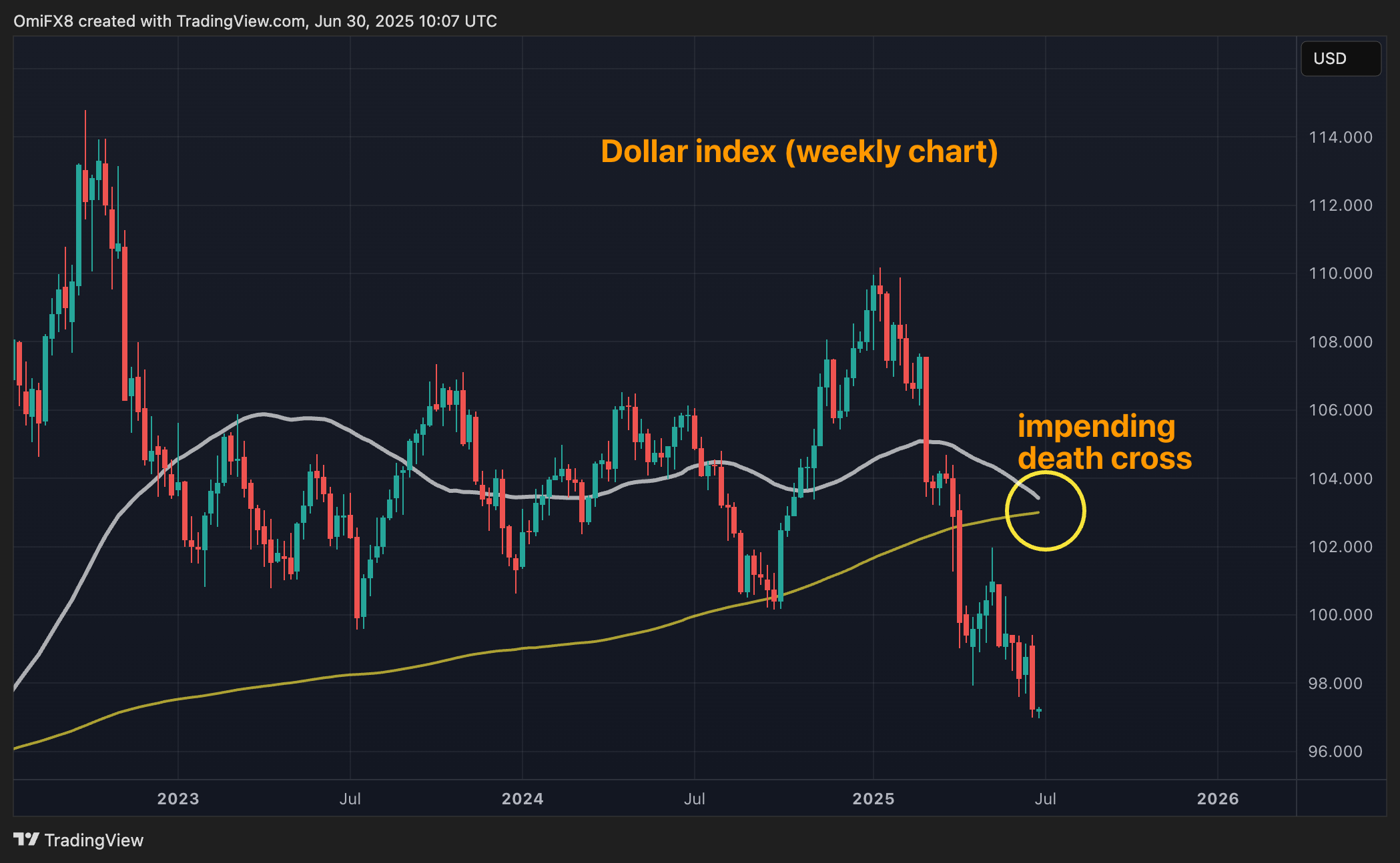
- The Dollar Index (DXY), which tracks the U.S. currency’s value against major fiat peers, appears on track to slip into an ominous-sounding death cross on the weekly chart.
- The death cross occurs when the 50-week simple moving average (SMA) dips below the 200-week SMA to suggest a deeper downtrend.
- The occurrence of the indicator, however, has consistently marked bottoms since 2008.
Crypto Equities
Starting today, the price quoted for Galaxy Digital will be for its Nasdaq-traded shares.
- Strategy (MSTR): closed on Friday at $383.88 (-0.66%), +1.48% at $389.55 in pre-market
- Coinbase Global (COIN): closed at $353.43 (-5.77%), +1.07% at $357.20
- Circle (CRCL): closed at $180.43 (-15.54%), -2.89% at $175.21
- Galaxy Digital (GLXY): closed at $19.97 (-2.49%), +2.2% at $20.41
- MARA Holdings (MARA): closed at $15.03 (-1.57%), +0.53% at $15.11
- Riot Platforms (RIOT): closed at $10.55 (+0.38%), +1.71% at $10.73
- Core Scientific (CORZ): closed at $16.65 (+1.77%), +4.62% at $17.42
- CleanSpark (CLSK): closed at $10.67 (-1.3%), +1.12% at $10.79
- CoinShares Valkyrie Bitcoin Miners ETF (WGMI): closed at $21.71 (+0.98%), +1.38% at $22.01
- Semler Scientific (SMLR): closed at $38.50 (-0.75%), +1.06% at $38.91
- Exodus Movement (EXOD): closed at $29.85 (+0.1%), unchanged in pre-market
ETF Flows
Spot BTC ETFs
- Daily net flows: $501.2 million
- Cumulative net flows: $48.85 billion
- Total BTC holdings ~1.24 million
Spot ETH ETFs
- Daily net flows: $77.5 million
- Cumulative net flows: $4.2 billion
- Total ETH holdings ~4.08 million
Source: Farside Investors
Overnight Flows
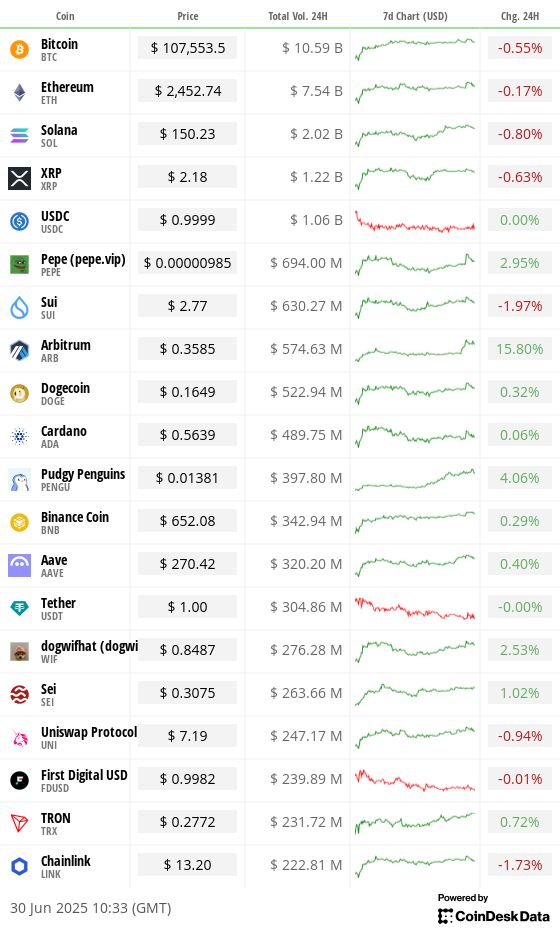
Chart of the Day

- Centralized exchanges registered a net inflow of $9.51 million in oracle service Chainlink’s LINK token last week, snapping a multiweek trend of outflows.
- Token inflows to exchanges are said to represent investor intention to liquidate holdings.
While You Were Sleeping
- Canada Rescinds Digital Services Tax to Advance Stalled US Trade Talks (Reuters): Canada scrapped its digital services tax late Sunday, just hours before it took effect, aiming to revive Trump-Carney talks and reach a trade deal by July 21.
- UN Inspector Says Iran Could Be Enriching Fuel Again in a ‘Matter of Months’ (The New York Times): The IAEA chief said it was premature to declare Iran’s nuclear infrastructure destroyed. Outside analysts said the biggest loss may be damage to sites for weaponizing enriched uranium.
- Bank of Korea Halts Digital Currency Project, Pausing Talks With Banks (The Business Times): The central bank paused the pilot, which had been scheduled for the fourth quarter, as President Lee prioritizes broader private-sector participation in won-based stablecoins, prompting regulatory debate over market safeguards.
- Bitcoin DEX Traders Position for Downside Volatility With $85K-$106K Puts, Derive Data Show (CoinDesk): As of Monday, 20% of decentralized on-chain derivatives platform Derive’s total BTC options open interest, valued at over $54 million, was concentrated in July 11 expiry put options.
- ‘Like Ordering McDonald’s:’ Malta’s MiCA Fast-Track Draws Oversight Concerns (CoinDesk): Some people think Malta is nimble and innovative when it comes to regulation. Others see a fast track to regulatory arbitrage.
- Bhutan Bets on Binance Pay to Power Crypto-Backed Tourism Economy (CoinDesk): Over 1,000 Bhutanese merchants now accept crypto payments from tourists via Binance Pay, which government officials praised for its ease of use and instant settlement.
In the Ether
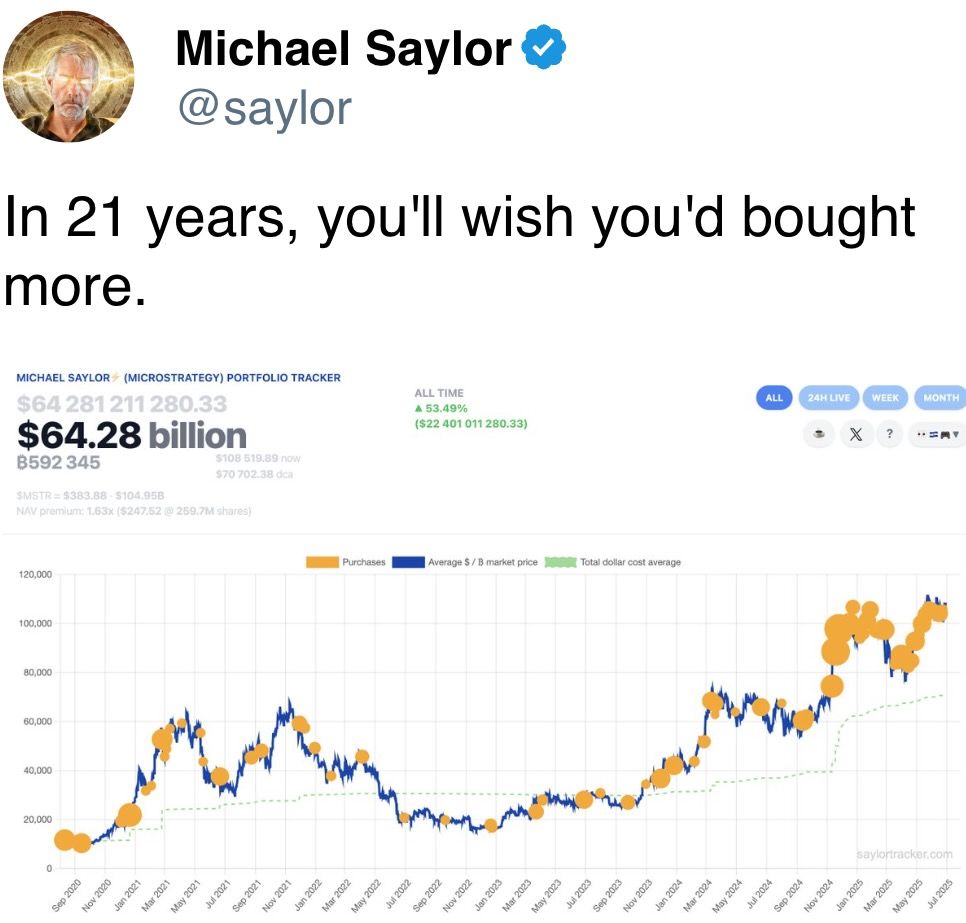
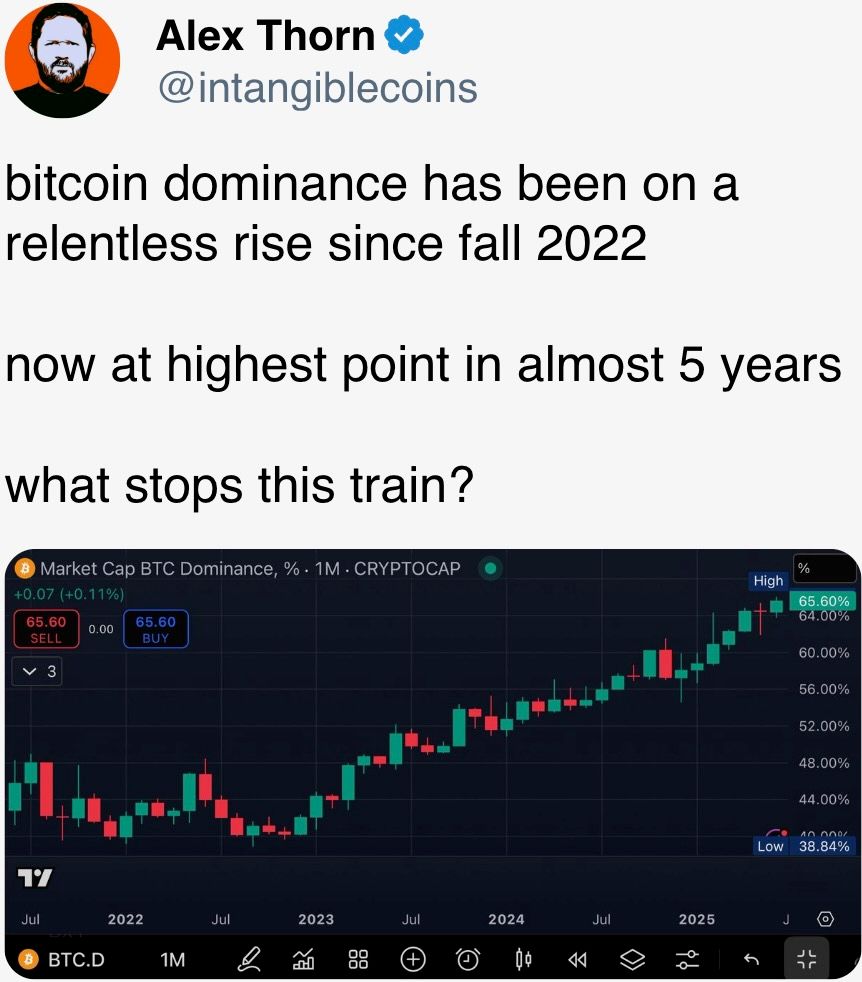
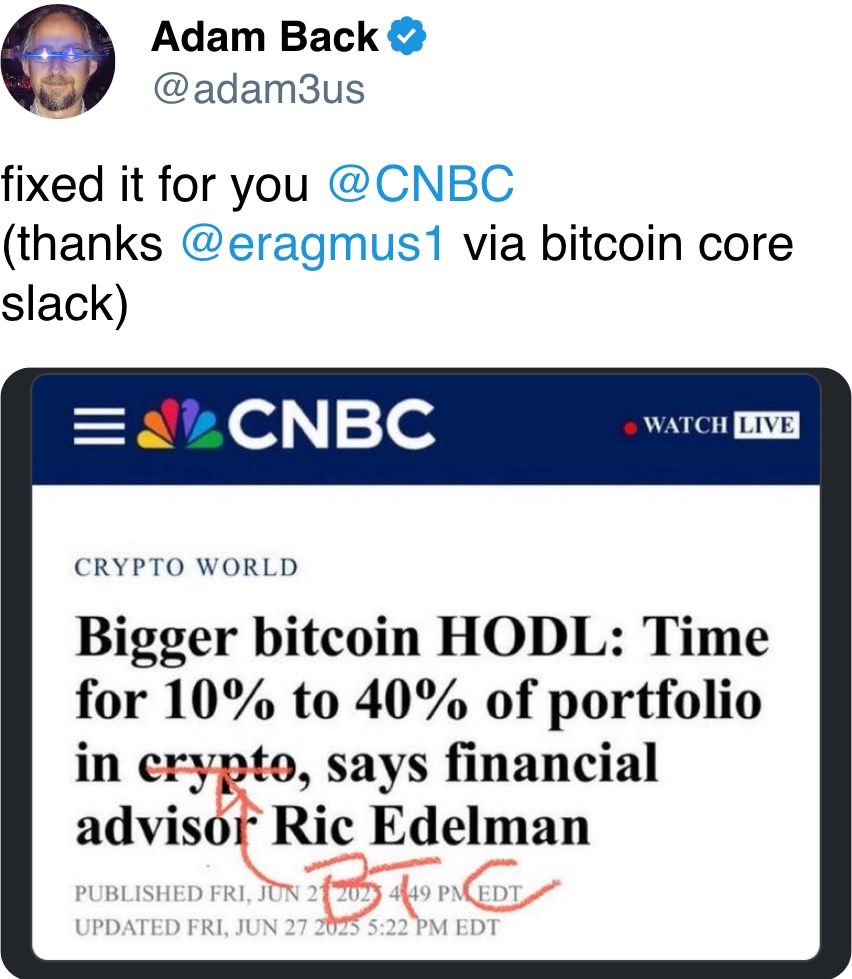


Uncategorized
Backed Finance Debuts Tokenized Stocks on Bybit, Kraken and Solana DeFi Protocols

Real-world asset tokenization firm Backed Finance is launching its tokenized stock offering on major crypto exchanges, and Solana (SOL)-based decentralized finance (DeFi) protocols, bringing equities like Apple, Amazon, and Microsoft and crypto-native platforms closer.
The offering includes some 60 equity and ETF tokens that are available for trading around-the-clock, the company said on Monday.
Crypto exchanges Bybit and Kraken are first to allow trading with the tokens, followed by integrations with DeFi apps Kamino Swap, Raydium and Jupiter later in the day, the press release said. The tokens will soon be available as collateral for DeFi lending, too, Backed said.
The move comes as momentum grows for bringing traditional financial instruments including equities onto blockchain rails, also known as tokenization of real-world assets. Crypto exchanges, such as Coinbase and Gemini, are seeking to expand into tokenized securities trading, while Robinhood was reportedly working on offering tokenized U.S. stocks for EU users.
Backed’s rollout fits into that trend. The firm is orchestrated the xStocks Alliance, a group of exchanges and DeFi apps committed to building an open onchain market for real-world assets.
«xStocks represent a monumental leap forward in democratizing access to financial markets,» Adam Levi, co-founder of Backed, said in a statement.
«By bringing familiar assets onto the blockchain with unprecedented accessibility, we are not just bridging traditional finance and DeFi; we are building the foundational blocks for a truly open, efficient, and inclusive global financial system where everyone can participate in wealth creation,» Levi said.
Read more: Gemini Rolls Out Tokenized Stocks in EU, Starting With Strategy Shares
-

 Business9 месяцев ago
Business9 месяцев ago3 Ways to make your business presentation more relatable
-

 Entertainment9 месяцев ago
Entertainment9 месяцев ago10 Artists who retired from music and made a comeback
-

 Fashion9 месяцев ago
Fashion9 месяцев agoAccording to Dior Couture, this taboo fashion accessory is back
-

 Entertainment9 месяцев ago
Entertainment9 месяцев ago\’Better Call Saul\’ has been renewed for a fourth season
-

 Business9 месяцев ago
Business9 месяцев ago15 Habits that could be hurting your business relationships
-

 Entertainment9 месяцев ago
Entertainment9 месяцев agoDisney\’s live-action Aladdin finally finds its stars
-

 Entertainment9 месяцев ago
Entertainment9 месяцев agoNew Season 8 Walking Dead trailer flashes forward in time
-

 Tech9 месяцев ago
Tech9 месяцев ago5 Crowdfunded products that actually delivered on the hype





